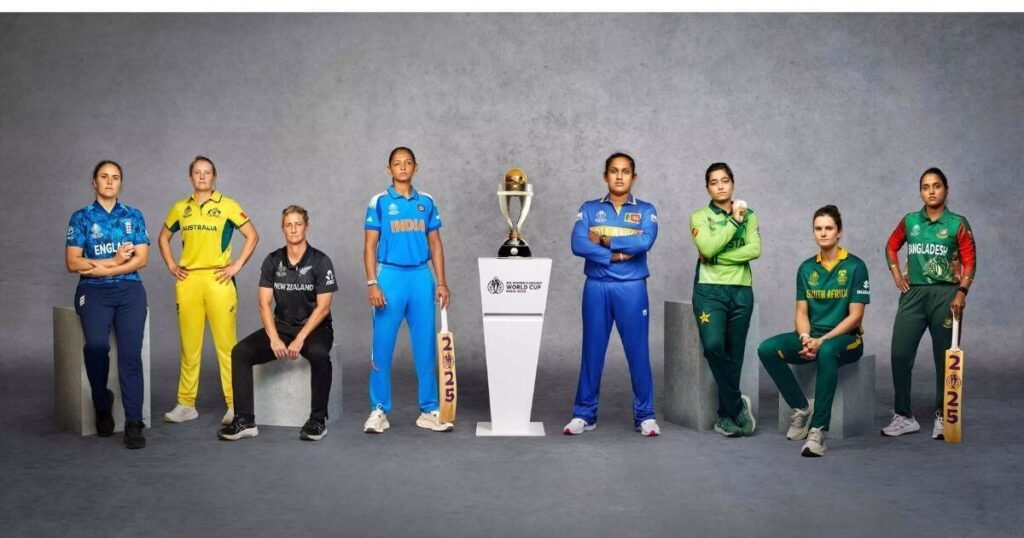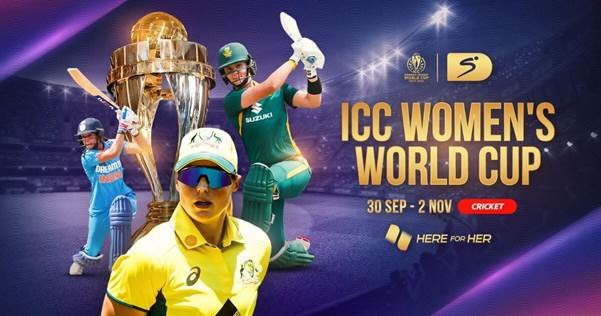Australia enters this Women’s Cricket World Cup defending their title, while England and India chase historic victories. Bangladesh, Pakistan, and Sri Lanka secured spots through a qualifying event held earlier in the year. The surprising absence of 2022 semi-finalists West Indies, who failed to qualify, reshapes competitive dynamics. Eight nations battle across India and Sri Lanka through October and November, with the hosts leveraging home advantage brilliantly.
Every team will play once during the round robin phase before top four teams progress to semi-finals scheduled for October 29 and October 30. The final unfolds on November 2 at Mumbai‘s DY Patil Stadium, offering unprecedented prize money compared to previous events. Semi-final 1 takes place in Guwahati or Colombo at 8:30pm AEDT, while Semi-final 2 completes the knockouts sequence. Automatic qualifiers from the ICC Women’s ODI Championship include New Zealand and South Africa alongside top five finishers.
Tournament Format & Structure
| Stage / Aspect | Details |
| Teams | 8 teams participate |
| Format | Group-stage fixtures at designated venues |
| Progression | Based on group-stage results; every win adds pressure on team charts |
| Placements | 5th–6th place: different allocations than 7th–8th place |
| Host Matches | Played on neutral territory |
| Finals | Champions crowned; winners earn significantly more than losing semi-finalists |
| Prize Pool | Guaranteed payouts for all teams; advancing increases earnings |
| Key Factor | Every match is crucial on the path to tournament glory |
The tournament features an eight-team event where all group stage fixtures determine progression through matches at designated venues. Each side competes in a series format, with teams finishing fifth, sixth receiving different allocations than those in seventh, eighth place. The game’s best moments emerge when each group-stage win adds competitive pressure to team charts.
Hosts face off across neutral territory, with the tournament final crowning champions who take home significantly more than losing semi-finalists. The overall pot structure ensures each group stage participant earns guaranteed amounts, while victors advancing through semi-final stages compete for the ultimate prize. Every match matters as teams navigate toward finals, where tournament glory awaits.
Form Guide
Australia
- Solid side, dominant ODI record.
- Beth Mooney stabilizes batting; Natalie Sciver-Brunt is ICC #2 ranked.
- Ellyse Perry, Ashleigh Gardner provide depth.
- Megan Schutt heads accurate pace attack.
- Meg Lanning’s side are reigning champions.
- Sophie Molineux back after knee surgery; provides spin with Alana King.
Australia enters this tournament with unmatched consistency, having passed double figures in every ODI and dominating through Beth Mooney’s calm head. Their batting order remains reliable with Natalie Sciver-Brunt currently ranked second in ICC ODI Batter Rankings, averaging more than 40 throughout her career. Ellyse Perry and Ashleigh Gardner add depth, while Megan Schutt leads their pace attack with precision. Meg Lanning’s Australians previously lifted the trophy with ease, and this squad’s balance suggests they’re poised to defend their title. Sophie Molineux makes her international return after undergoing knee surgery in January, strengthening their spin options alongside Alana King.
India
- Smriti Mandhana on song, 800+ runs, avg 60+.
- Deepti Sharma: 59 wickets; Renuka Singh main new-ball bowler.
- Jemimah Rodrigues middle-order strong finisher.
- Intensive practice with bowling coach Avishkar Salvi on spin grip/rhythm.
- Pratika Rawal back after 2024 T20 World Cup, struggles with rustiness.
India’s form looks promising as Smriti Mandhana reclaimed the top spot with more than 800 runs in recent months, averaging above 60. Deepti Sharma has taken 59 wickets while Renuka Singh provides crucial new-ball control that can pose challenge to right-hand openers. Jemimah Rodrigues showcased her finishing ability during the tri-series in South Africa, slotting seamlessly into the middle order. Their preparation included methodical sessions with Avishkar Salvi, the bowling coach, working on Rana’s offspin grip and rhythm. Pratika Rawal faces a test against quality attacks after match rustiness, having last played international cricket at the 2024 T20 World Cup.
In the Spotlight / Key Players

| Player | Key Highlights | Role / Impact |
| Georgia Plimmer (20) | Scored 112 in March to seal series win; rising talent | Young match-winner; faces test vs top new-ball bowlers |
| Harshitha Samarawickrama | Consistent scorer; 77 against strong opponents; solid technique | Dependable batter; entering prime form |
| Chamari Athapaththu | Provides aggressive starts; balances middle order | Power-hitter & stabiliser |
| Marizanne Kapp | 121* on return; 130+ ODIs since 2009; experienced & balanced performer | Veteran all-rounder; key in middle order |
| Laura Wolvaardt | Reliable anchor; shifts gears when required | Long-term top-order anchor; adaptable |
| Diana Baig | Captain; 4 fifties at 90+ strike rate; stabilises & accelerates | Star all-rounder & leader |
| Sidra Amin (33) | Back-to-back centuries in 7 ODIs; multiple fifties | Consistent run-machine; senior batter |
The fastest hundreds in women’s ODIs belong to batters who’ve smashed records while confirming their ability to dominate quality attacks. Georgia Plimmer, at just 20 years old, delivered match-winning knocks including a 112 in March that set up a series victory. Her challenge lies in facing top-class new-ball bowlers during this global event. Harshitha Samarawickrama, a dependable batter in recent years, has been a consistent run scorer with 77 against strong opponents. Entering her prime, her technique helps counter varied bowling alike. Chamari Athapaththu is often tasked with providing fast starts while maintaining balance in the middle order.
Marizanne Kapp returned to ODI cricket after being rested and immediately found form with 121* against quality opposition. The veteran has played more than 130 ODIs since her debut in 2009 and brings balance alongside Laura Wolvaardt, the long-term anchor who can shift gears and adds edge. Diana Baig will be one to watch as captain and star all-rounder who scored four fifties at a strike rate above 90. She’s a rare batter who can both stabilise and accelerate when needed. Sidra Amin has been relentless with back-to-back centuries in seven ODIs and crossed fifty multiple times for her country’s cause at 33.
Eight Batters Tipped to Shine
- World Cup debuts put natural ability to the test when it matters.
- Smooth pitch conditions at certain grounds encourage aggressive batting.
- Kavisha Dilhari: Seasoned, can readjust quickly to match situations.
- Vishmi Gunaratne: Typical opener, can bat at No. 4; crucial run-scorer.
- Phoebe Litchfield & Georgia Voll: Australian rookies bringing new energy.
- Success relies on managing field restrictions well.
World Cup debuts often reveal natural talents under pressure, where runs and precise shot selection matter most. Fans debating early form overlook how flat pitch conditions at certain venues favor aggressive batting. Kavisha Dilhari brings invaluable experience, having already settled into various match–specific scenarios during recent tours.
The tone of this Women’s Cricket World Cup will be shaped by those making their maiden appearance, particularly batters capable of swinging fortunes with memorable innings. Vishmi Gunaratne typically an opener, could bat at No. 4 and make significant contributions when it matters. Key players like Phoebe Litchfield and Georgia Voll joining Australia’s squad for the first time adds fresh energy. Their ability to play under field restrictions becomes key.
Team News
Sri Lanka
- Team undergoes significant changes.
- Inoka Ranaweera: Seasoned spinner, fine-tuned catching practice.
- Malki Madara & Hasini Perera: Standout performances during warm-up matches.
- Sugandika Kumari: Fitness issues remain.
Sri Lanka faces this ICC Women’s Cricket Cup with a squad that’s undergone significant changes. Inoka Ranaweera, the experienced left-arm spinner, brings stability after training sessions showed improvement in her catching drills at the nets. Meanwhile, young seamer Malki Madara and Hasini Perera have impressed during warm-up games, though concerns remain about Sugandika Kumari’s fitness.
India
- Extensive preparation under the leadership of Kranti Goud to counter middle-over challenges.
- Dewmi Vihanga & Udeshika Prabodhani: Workload management for optimal form.
- Team integration will be the key to perform in September’s matches.
India’s preparation has been thorough, with Kranti Goud working on specific challenges in the middle overs. Offspinner Dewmi Vihanga and Udeshika Prabodhani have been managing workload carefully to maintain peak performance for the tournament. Cohesion between these undercooked sides will determine who proves well-prepared with clear goals for September’s contests.
Stats and Trivia
| Category | Details |
| Match Officials | All-female panel since 2022 Commonwealth Games |
| Total Umpires | 14 |
| Third Cup Appearance | Claire Polosak, Jacquline Williams, Sue Redfern |
| Second Cup Appearance | Lauren Agenbag, Kim Cotton |
| Opening Match Umpires | Claire Polosak, Eloise Sheridan (both Australians) |
| Prize Pool (2025) | US$13.88m (A$21m), quadrupled from 2022’s US$3.5m (A$5.3m) |
| Comparison | Surpasses men’s 50-over Cup prize pool: US$10m (A$15m) |
| Winner’s Prize | US$4.48m (A$6.9m) |
| Guaranteed Per Team | US$250k (A$382k) |
| Losing Semi-Finalists | US$700k (A$1.07m) |
Women’s Cricket World Cup have featured all-female panel of match officials since the Commonwealth Games in Birmingham, with 14 umpires now on line. Claire Polosak, Jacquline Williams, and Sue Redfern are appearing at their third Women’s Cup. Lauren Agenbag and Kim Cotton reach their second Cup, while Australians Polosak and Eloise Sheridan serve as on-field umpires for the tournament opener.
The prize pool quadrupled from the 2022 event’s US$3.5m (A$5.3m) offer to US$13.88 million (A$21 million), far eclipsing the most recent men’s 50-over Cup at $US10m ($A15m). Winners receive US$4.48m (A$6.9m), more than double what Australia took home as runners-up previously. Each team is guaranteed to earn US$250k (A$382k), while losing semi-finalists get US$700k (A$1.07m).
Host Venues
- Original host: Bengaluru, but issues over permission put the brakes on.
- Replacement city: Temporary replacement in Navi Mumbai.
- Final venue: Holkar Stadium in Indore to host the critical matches.
- Broadcast: All matches accessible globally.
- Venue impact: Needs adaptation by the teams according to local conditions.
- New Zealand arrival: Tuesday, September 30.
- Group phase action: From October 1 onwards.
- Hosting rights: Changed several times before a final decision.
The venue originally set for hosting was Bengaluru, but the city proved unable to secure the permit last month. Schedule changed after this setback, with Navi Mumbai stepping in as a replacement host city. Indore’s Holkar Stadium ultimately became the finalized venue where key matches would unfold. Broadcast details confirmed that every game would be accessible, ensuring fans worldwide could follow their teams’ fortunes.
The venue’s selection brings fascinating dynamics as teams adjust to local conditions. New Zealand arrives on Tuesday September 30, ready to compete in what marks another significant chapter. October 1 sees continued action as the tournament progresses through its group phase. Hosting rights shifted multiple times, yet the final venue delivers everything needed for world-class cricket action unfolding before passionate supporters.
How to Watch / Broadcasting
| Category | Details |
| Match Time | 3:00 PM local time (7:30 PM AEST) |
| Broadcast Access | Official tournament website + multiple platforms |
| Venues (2025) | Holkar Stadium, Indore; ACA-VDCA Stadium, Visakhapatnam |
| Tickets | Available for live attendance at venues |
| Commentary – Cup Winners | Mel Jones, Isa Guha, Stacy-Ann King |
| Commentary – Former Captains | Sana Mir, Anjum Chopra |
| Commentary – Guest Stars | Aaron Finch, Carlos Brathwaite, Dinesh Karthik |
| Commentary – Experts | Ian Bishop, Katey Martin, Natasha Farrant |
| Commentary – Broadcasters | Alan Wilkins, Natalie Germanos |
| Emerging Broadcasters | Raunak Kapoor, Jatin Sapru |
The Women’s ODI Cup offers broadcast details across multiple platforms, with matches starting from 3pm local time (7.30pm AEST). Fans can visit the official tournament website for comprehensive viewing options. Tickets are now available for those preferring live attendance at venues like Holkar Stadium, Indore and ACA-VDCA Stadium, Visakhapatnam. More details emerge as the 2025 edition unfolds across familiar grounds.
A star-studded, female-led commentary team will provide expert insights, featuring Cup winners like Mel Jones, Isa Guha, and Stacy-Ann King. Former captains including Sana Mir and Anjum Chopra join behind the microphone, while Aaron Finch, Carlos Brathwaite, and Dinesh Karthik add star power. Ian Bishop, Katey Martin, and Natasha Farrant complete the lineup alongside experienced broadcasters Alan Wilkins and Natalie Germanos, with emerging broadcasters Raunak Kapoor and Jatin Sapru joining coverage.
Women’s Cricket World Cup Tickets
- Streaming: Available for free on Prime Video (no paywall).
- Access: Australian audiences require only a free Amazon account.
- Coverage: All 31 matches live & exclusive.
- Start Times:
- 7:30 PM AEST (Eastern seaboard)
- 5:30 PM WA (Western Australia)
- 7:00 PM NT (Northern Territory)
- 8:00 PM ACDT (Victoria, NSW, Tasmania after Oct 5 daylight savings)
- Flexibility: Final matches can disrupt habits; viewers may look for work concessions.
- Options: View live or 10–25 min highlights packages
Cricket fans eager to tune in can watch every clash as Prime Video offers free streaming, removing the paywall. Australian viewers only need to sign up for a free Amazon account to access All 31 matches broadcast live and exclusive. The broadcaster ensures upcoming games begin at prime time, with 7.30pm AEST slots for the Eastern seaboard.
Time difference means Western Australia sees games at 5.30pm, while 7pm suits Northern Territory schedules. Before daylight savings kicks in on October 5, Victoria, NSW, and Tasmania shift to 8pm ACDT following time zones adjustments. Keen fans needing to stock up on caffeine for late start times can ask bosses for flexibility, though games scheduled to end in wee hours of the morning may treasure sleep routines. The choice between live broadcast or 10 to 25-minute highlights packages lets viewers decide their feature.
Women’s Cricket World Cup Prize Money
- Financial incentives to be more aggressive than previous versions.
- Prize pools capture cricket’s new boom.
- Best performers get bigger slices.
- Principles of equal distribution highlighted across teams.
- Increased value provided for every playing country.
- Prize distribution increases tournament gravitas.
- Transparency remains paramount in determining payouts.
- Consistent performance rewarded under new format.
Expected financial rewards at this tournament aim to become more competitive than previous editions. Tournament organizers work behind scenes to ensure difference in prize pools reflects modern cricket’s growth. Reliable sources indicate payouts could stand out significantly. The best performers will naturally secure larger shares. Finally, equal distribution principles take on greater importance across participating teams.
Recent financial structures bring enhanced value for all involved nations. Prize allocation remains a vital factor determining tournament prestige. Organizers keep transparency central while determining final amounts. Leading teams naturally pursue both glory and financial recognition. This year’s structure puts emphasis on rewarding consistent performance throughout.
Match Officials
- Match officials oversee decision-making roles.
- Their experience assists teams in coping with intense pressure situations.
- Fair play facilitated through consistent umpiring.
- Contemporary cricket requires calm judgment of disputed appeals.
- Their function of enforcing regulations forbids unfair benefits.
- Experienced officials entrusted with key positions in all formats.
Match officials possess control over every decision-making aspect during the game. Their experience shapes how teams negotiate intense moments under high pressure. Reliable umpires take their places ensuring fair play remains unmatched. The pace of modern cricket demands calm judgment from officials who handle contentious appeals with beneficial authority.
Throughout tournament history, officials manage to keep proceedings within acceptable boundaries despite recent controversies. Their ability to means enforcing regulations prevents any team from gaining unfair advantage. Already experienced officials occupy central roles, having dealt with complex situations across multiple formats.
ICC ODI Rankings
| Category | Details |
| Purpose | Provides reliable insight into how teams approach international cricket |
| Ranking System | Updates after each match; reflects form & performances across venues |
| Leading Sides | Strong in both batting and bowling departments |
| High-Ranked Teams | Feature experienced players with exposure to varied pitches |
| Key Factors | Consistency, recent contributions, ability to handle pressure situations |
| Updates | Regular updates ensure rankings stay current with ongoing tournaments |
The ICC‘s ODI team charts provide reliable insight into how teams approach international cricket. Currently, several sides are navigating tournaments with players who have produced consistent numbers that speak for themselves. Rankings shift after each match, reflecting form and performances across different venues.
Leading sides include those with strength in both batting and bowling departments. Teams ranked higher often feature players with extensive experience, including those who have played across various pitches. The list updates regularly, capturing recent contributions from key performers who handle pressure situations effectively.
Previous Winners
| Team | Titles Won | Last Title / Final | Notes |
| Australia | 7 | Multiple (most recent dominant win) | Most successful team; consistent across formats & venues |
| England | Multiple | 2017 (beat India at Lord’s) | Closest rival to Australia; historic success across eras |
| India | 0 | 2017 Final (lost to England) | Still seeking maiden title; strong progress |
| New Zealand | 1 | 2000 | Past champions, long gap since victory |
| West Indies | 1 | 1979 | Former champions; decades since last win |
| South Africa | 0 | Reached knockouts several times | Yet to win despite producing world-class players |
| Bangladesh | 0 | — | Developing rapidly with better infrastructure & coaching |
| Pakistan | 0 | — | Building competitiveness with program improvements |
| Sri Lanka | 0 | — | Focused on growth with upgraded coaching & facilities |
Australia has claimed the trophy at seven World Cups, dominating women’s cricket with unmatched consistency. Their squad features experienced campaigners who understand pressure situations, making them favorites in every tournament. The team’s strength lies in their ability to perform across formats, whether on home soil or during overseas campaigns. England remains their closest rival, having won multiple titles through different eras of the game.
India reached their first final in 2017 but fell short against England’s powerful lineup at Lord’s. New Zealand and West Indies also feature among previous champions, though decades have passed since their victories. South Africa continues seeking their maiden title despite producing world-class talent and reaching knockout stages repeatedly. The competition grows fiercer as Bangladesh, Pakistan, and Sri Lanka develop their programs with better infrastructure and coaching.
Australia’s Group Stage Matches
| Date | Opponent | Venue | Notes / Timing |
| Oct 1, 2025 | New Zealand | Holkar Stadium, Indore | Tournament opener for Australia (icc) |
| Oct 4, 2025 | Sri Lanka | R. Premadasa Stadium, Colombo | Part of group rotation into Sri Lanka (Cricbuzz) |
| Oct 8, 2025 | Pakistan | R. Premadasa Stadium, Colombo | Australia vs Pakistan group match (ESPN.com) |
| Oct 12, 2025 | India | ACA-VDCA Stadium, Visakhapatnam | High-profile group clash (Cricbuzz) |
| Oct 16, 2025 | Bangladesh | ACA-VDCA Stadium, Visakhapatnam | Group match vs Bangladesh (Cricbuzz) |
| Oct 25, 2025 | South Africa | Holkar Stadium, Indore | Group match toward end of stage (ESPN.com) |
| Oct 22, 2025 | England | Holkar Stadium, Indore | Group match vs England (Cricbuzz) |
Australia enters the Women’s Cricket World Cup at their peak, with top-order batters showing remarkable form during recent tours. The defending champions face little worry despite Grace Harris being ruled out after suffering a calf strain in the third ODI last Sunday. Heather Graham, the WA allrounder, was included as her replacement and could provide crucial depth. Their opening game will test whether new ball strategies against swing ball conditions remain effective. Tahlia McGrath (vc) and Alyssa Healy (c) must lead with precision. Annabel Sutherland and Kim Garth will feature prominently after brushing off minor niggles ahead of the competition.
The Australian squad aims to become the first women’s team to claim consecutive titles in this prestigious 50-over Cup. Darcie Brown recovered from a quad issue while Georgia Wareham overcame a groin concern, ensuring five players remain match-winning assets. Their bowling attack, which claimed 26 wickets across previous ODIs, will target early breakthroughs at familiar territory venues. Aiming for an unprecedented seventh championship, they begin their quest with calculated aggression. Cricket Australia named a 15-player squad carefully prepared for varied conditions, demonstrating why they remain ranked number 1 globally. This group understands the gap between expectation and execution has shrunk significantly among competing nations.
When Does Women’s Cricket World Cup Start?

- October 1 is the tournament’s opening day with two matches.
- Matches will set the tone for weeks of competition.
- Fans around the world are looking forward to drama and intensity.
- Opening games put teams’ preparedness to the test.
- Favorites vs underdogs dynamic will be clear early.
- Teams entered with focused final preparations.
- Global spotlight shines on confident players despite detractors.
October 1 marks the match when anticipation transforms into reality for fans worldwide. The opening day brings two games that will set the tone for weeks of competition. Cricket enthusiasts need to mark calendars as the tournament begins with unexpected intensity. Every match promises drama as teams return to prove themselves on the big stage.
The first encounters will reveal which sides have truly prepared for this moment. Eager supporters can expect the gap between favorites and underdogs to be tested immediately. Teams have shrunk their final preparations into focused session work before stepping into the spotlight. The light of global attention falls on players who appear confident despite muted expectations from critics.
Frequently Asked Questions (FAQs)
When was the first Women’s Cricket World Cup held?
The first Women’s Cricket World Cup was organized in 1973 in England, two years ahead of the men’s World Cup.
How often is the Women’s Cricket World Cup played?
The event is contested every four years under the 50-over format of the ICC.
Which team has won the most Women’s Cricket World Cups?
Seven titles have been won by Australia, dominating the competition.
How many teams participate in the Women’s Cricket World Cup?
Eight teams participate currently, determined by automatic qualification and qualifiers.
What is the prize money for the Women’s Cricket World Cup?
The 2025 tournament provides a record US$13.88 million, and winners earn US$4.48m.
Read More Blogs Here:
Nick Hillary Net Worth $1 Million: A Powerful Story of Resilience
Brandon Steven Net Worth $30M: A Powerful Success Story
Italy’s Ports Blocked as Gaza Protests Sweep Nation
Conclusion
Batter resilience defines tournaments where bowlers create shaping difference through crucial spells. Mental temperament separates champions from contenders, particularly when pacing innings under pressure situations. Anchor roles demand timing precision, allowing teams to bat through challenging phases. Reliable opener strategies combine productivity with calculated aggression against best pacers worldwide.
Tournament history reveals how consistent batter performances across calendar year cycles determine ultimate success. Players able to outscore peers during qualifiers often become leading run-scorer when stakes rise highest. Chases require unique mental frameworks, blending attacking mindset with measured shot selection against quality opposition consistently.
Dua Mahfooz is an experienced journalist and financial analyst for Pakistan Coverage, specializing in celebrity net worth analysis, entertainment industry trends, and breaking news. With expertise in wealth assessment and market research, she provides accurate financial insights on public figures alongside comprehensive coverage of political, economic, and social developments. Her commitment to thorough research and fact-checking ensures reliable, well-sourced content across diverse topics.




